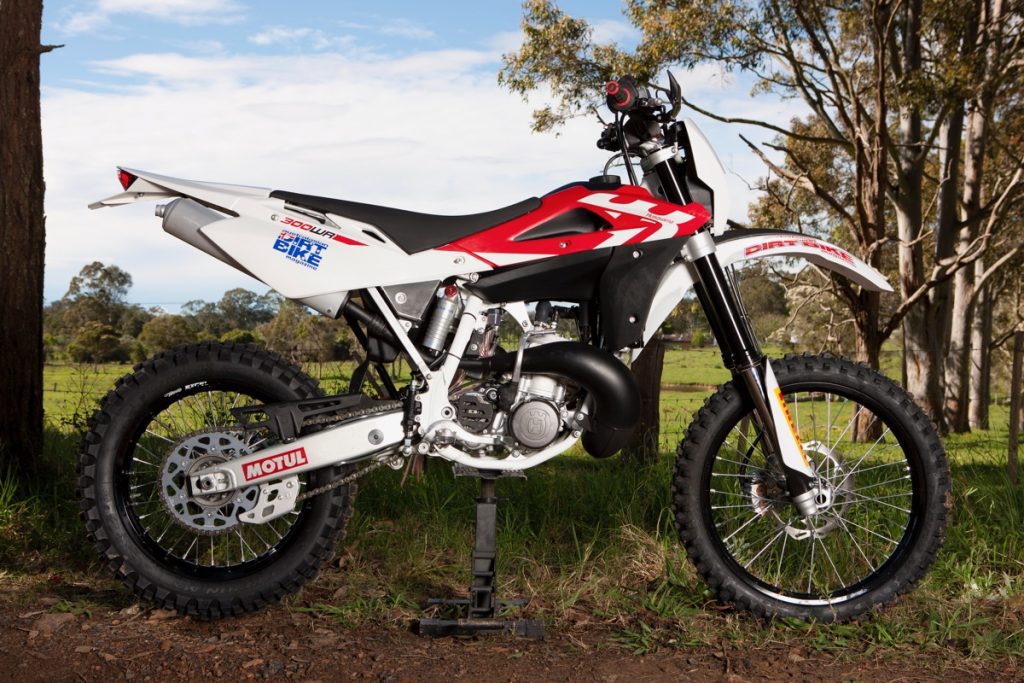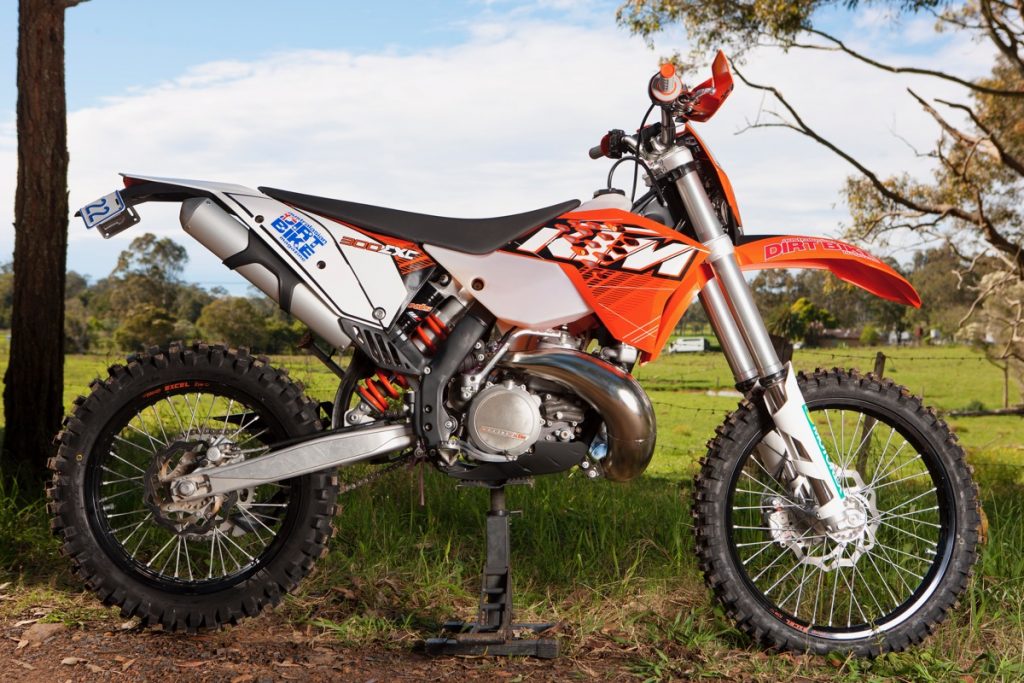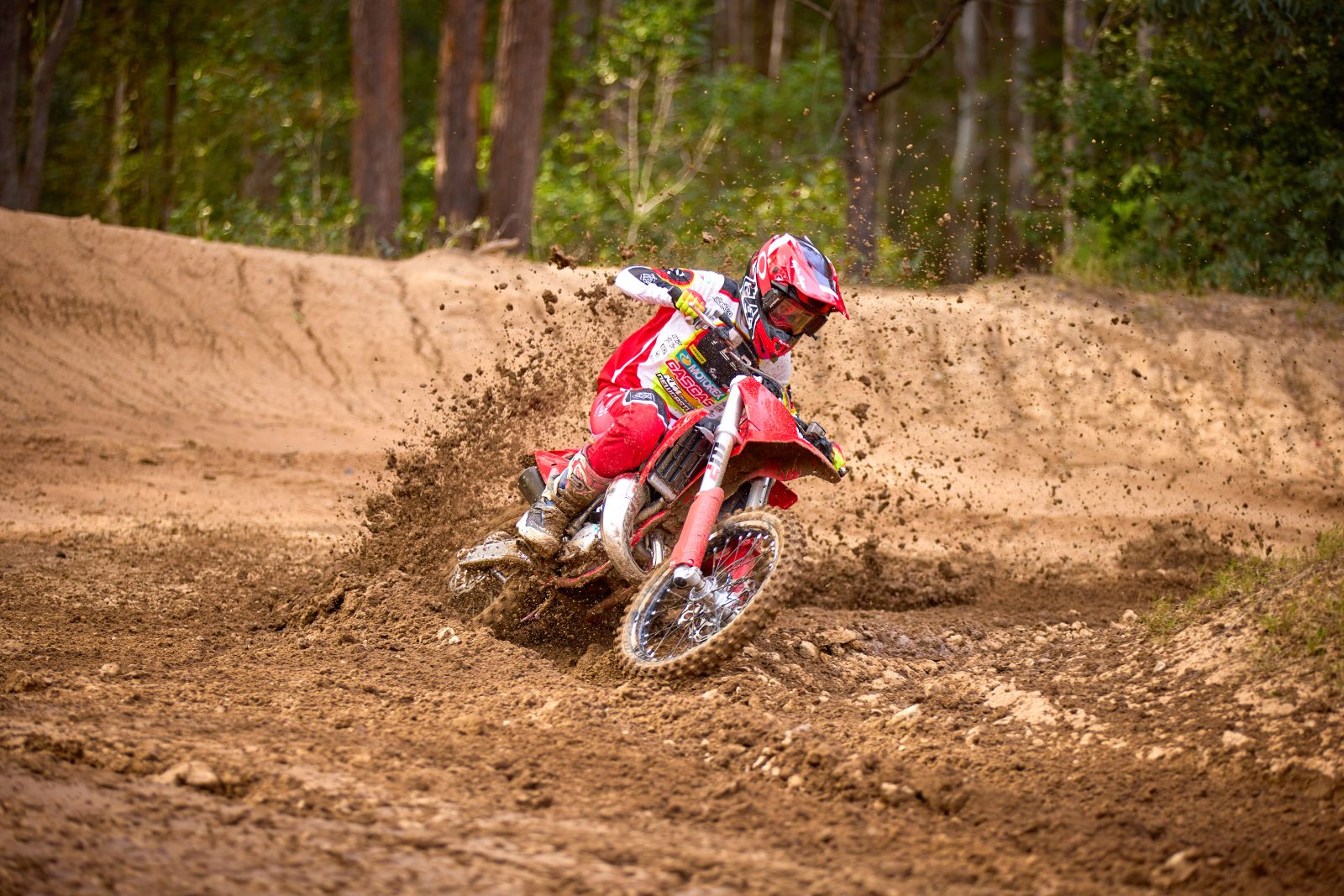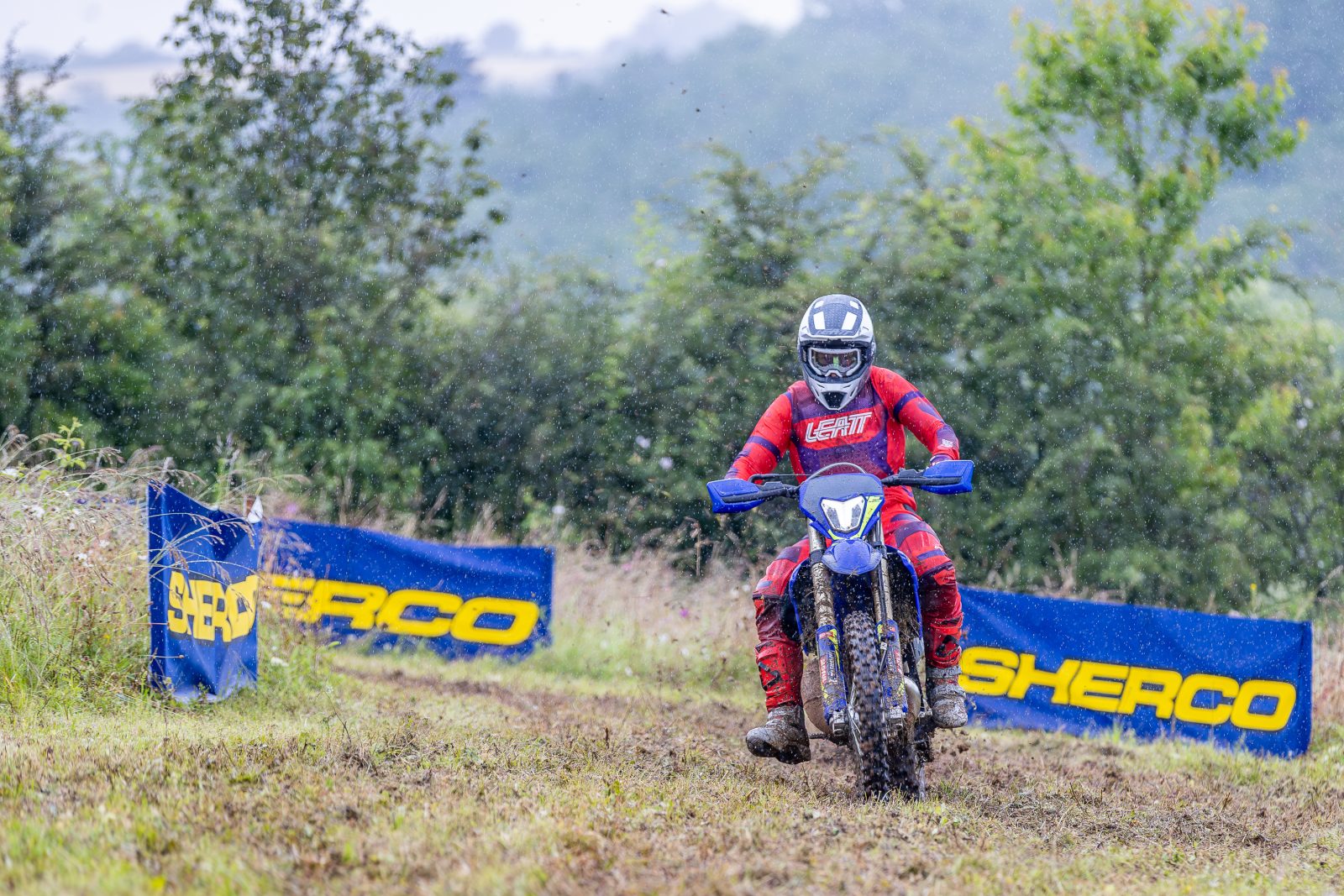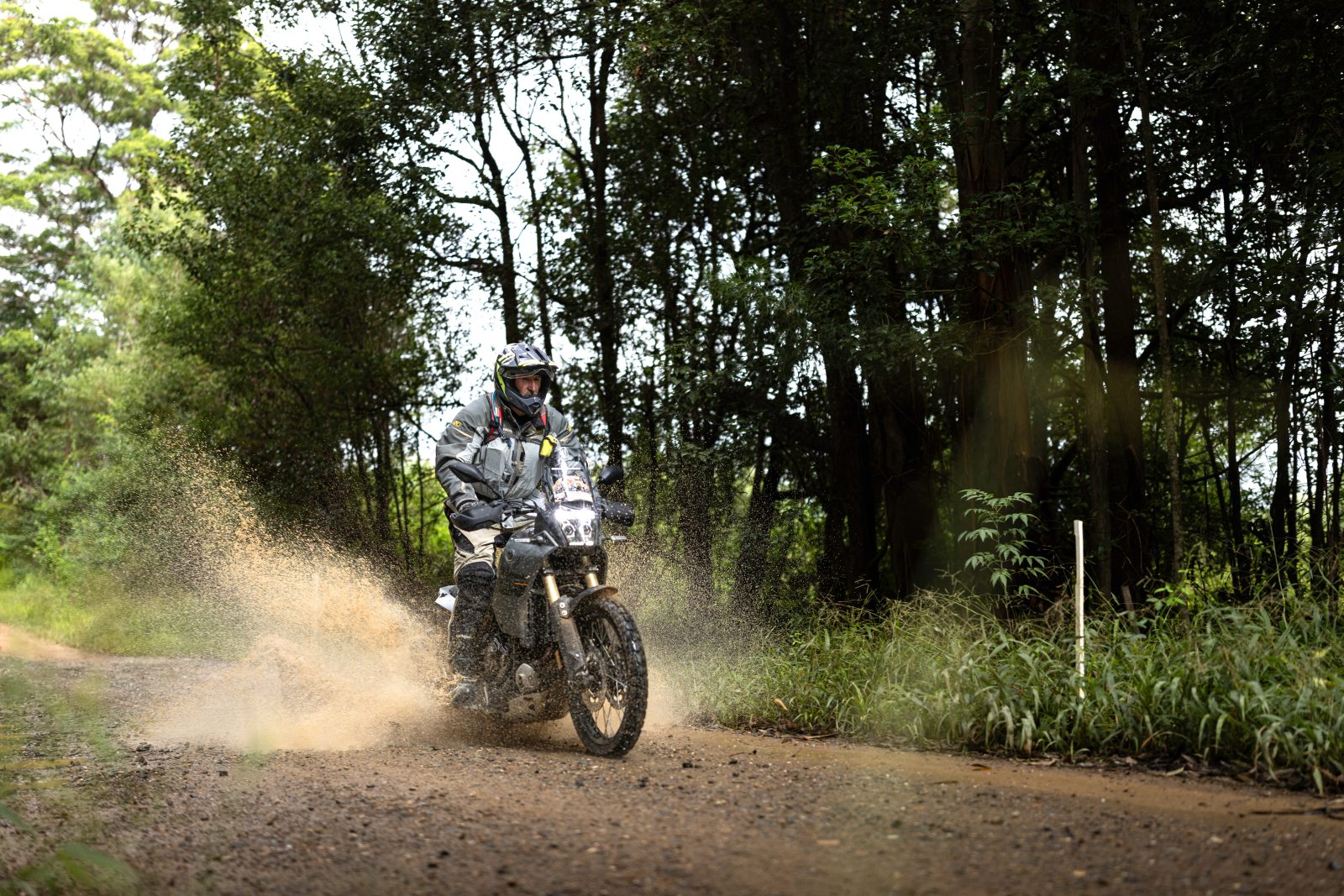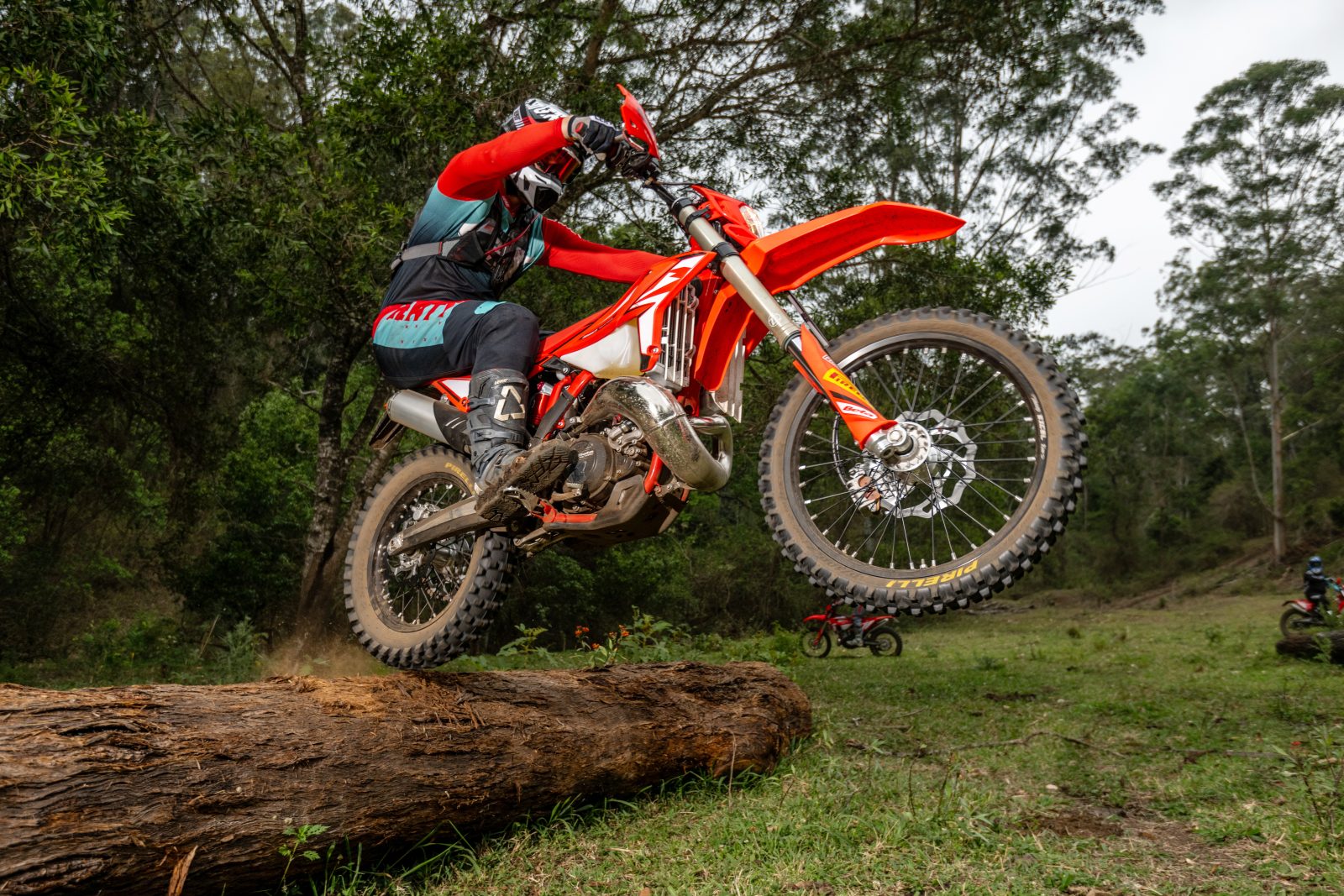It was also the only 300 two-stroke in the Enduro Top-10. So while 300EXC sales experienced 22% growth, its four-stroke rivals saw their sales fall off a cliff. The worst-hit was the 300EXC’s stablemate, the 450EXC, which in 2010 saw its sales fall by 38.4%, I wonder why…
Looking at 2009 sales results, the 300EXC experienced even stronger results with 24.7% growth from 2008. However, it was still comfortably outsold by the mighty KTM 530EXC and 450EXC, Honda CRF450X, Yamaha WR450F and Suzuki DR-Z400E. It even lost out to the KLX250, TT-R250, and WR250F. To truly appreciate how far the 300 two-stroke enduro has come in the eyes of the consumer, you just need to look at sales figures from 2007, when the 300EXC wasn’t even on the charts and the Enduro Top-10 was exclusively Japanese four-strokes, expect for the KTM 250EXC-F and 450EXC. But the writing was on the wall and the 300 two-stroke was on the way up.
Revisit the 2011 300 two-stroke enduro shootout featuring the Husqvarna WR300, Husaberg TE300, KTM 300EXC, TM EN300 and Gas Gas EC300.
THIS 300 TWO-STROKE SHOOTOUT WAS PUBLISHED IN ADB ISSUE #376 – JANUARY 2011 || Words // Ant Lyon Pics // Chris Benny
Husqvarna WR300
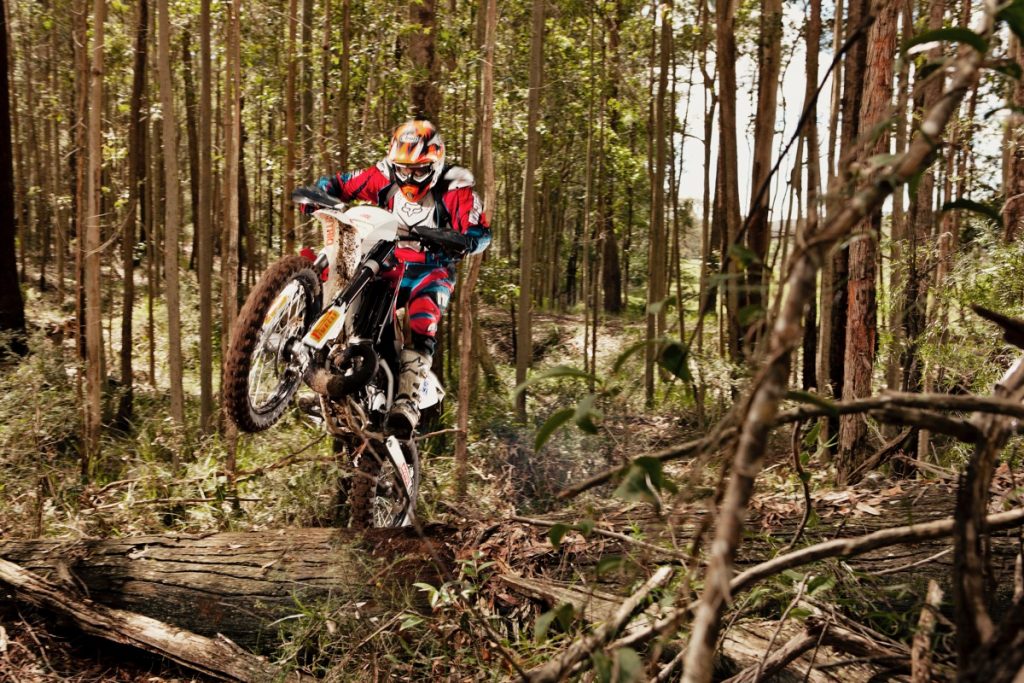
There’s something raw and old-school about Husky’s WR 300. From its chain and sprocket on the “wrong” side of the bike to its throaty two-stroke wail reminiscent of a motocrosser from a bygone era, the WR takes a simplistic approach, where flashy gimmicks like electric starting and dual curve ignition switches are just more things to go wrong. But, before you start thinking Husqvarna simply slapped a “2011” label on last year’s bike, their latest three-hunge has some subtle and important changes that make it better than ever.
Snap, Crackle and Roar
While remaining one of the most aggressive and exciting engines in the 300 two-stroke class, for ’11 the WR gets its broadest power spread yet thanks to the new Ducati Energia ignition, tuned for a smoother, more tractable output than last year. It’s still an engine that comes on strong and can be a handful – lighting up easily in the slippery stuff or when you get over exuberant on the throttle.
It’s not as strong off the bottom as the other bikes in the bunch, but a bit of good clutch control is all it takes to get the engine to spin up and deliver its meaty midrange to the ground. Unfortunately, the WR’s cable clutch is also the stiffest of the bunch and harder work to feather.
A couple of our testers commented the heavier lever even caused the occasional drama with quick gear changes, so a hydraulic (or even a lighter cable clutch) would make harnessing the Husky’s horses an easier task. The good news is riders can click a taller gear and enjoy torquing it from corner to corner.
In the drag race, the punchy WR powerplant rocketed its rider to an early lead, but ran out of legs earlier, losing the most ground to the six-speed box shared by the KTM and Husaberg. Going a tooth or two smaller on the rear sprocket would be an easy mod for that extra bit of top-end speed and to spread out the gear ratios a little in the trees.
Trail mix
While the engine comes into its own at race pace the rest of the package is more attuned to the needs of the trail rider. With its roomy cockpit and comfortable “sit in” feel, the Husky is made for eating up the trail miles with no complaint and happily accommodates riders at both ends of the size spectrum.
Although feeling like it has the heaviest steering when you first throw a leg over it, the WR quickly proved to be the quickest turning bike at the Shootout, and the easiest to carve through sandy berms and flowing singletrail. The trade off was the most headshake at speed – something that can be minimised by sliding the fork down in the triple-clamp or running a little more sag in the rear shock.
For the trail rider, the KYB fork and Sachs shock is a plush and compliant package that gives little cause for complaint, until you start to push it, when things start to get a little sketchy. Both ends are valved too soft, and – at race pace – can suddenly deflect off a slippery root or rock and put you on the ground or into a tree, as happened to me on a section of root-infested trail I’d ridden happily through nine times previously.
Opinions were divided about the Husky’s looks, with Braico claiming it “looks sick” and Grabbo saying it was one of the most dated looking bikes of the bunch. Beauty truly is in the eye of the beholder!
The last word
If you’re looking for a trail-friendly, no frills ride the Husky is a bulletproof choice. It’s easily tamed, comfortable, roomy and is a steal at $10,495 (that’s $2100 less than the ’Berg!). However, start pushing for stage wins out of the crate and you’re in for a white knuckle ride. It’s a great bike which just needs some further refinement to keep pace with its competitors, starting with an electric leg (or a better kick start lever) and a lighter clutch pull.
Lap times
Pro Lap = 1:53.7sec
Expert Lap = 2:05.1sec
TM EN300

The undisputed animal of the fierce five is the TM EN300. Like a thoroughbred horse, its bloodlines point to a racing heritage, where performance is the key virtue and the rider is expected to lift his or her game to match their mount – not the other way around.
A bite to match its bark
It’s the most agro motor of the lot with a soft bottom-end, transitioning abruptly into a mid-range surge and ballistic top-end more suited to motocross or fast open conditions, where the throttle can be held wide-open.
While the TM boasted the most exciting delivery of the bunch, it also meant it was a handful in tight singletrail conditions and on steep, technical hills. Brett Kenny wasn’t the only rider to encounter problems with Tyson-like punch. “I could hold onto it, but it was very tiring, which got old pretty quickly!”
For 2011, TM claim the revised EN300 engine offers boosted low-to-mid-range roll-on power and longer service intervals thanks for the new cylinder and port layout. All well and good, but what we really hoped to see was the JRF Torque Control (designed by the late, great John Hall) fitted to the power valve mechanism as on the 2010 bike. The unit, now available separately for $495, was brilliant on our Long Term Test Bike last year and allows the rider to literally dial in the degree of engine “hit”. “I loved last year’s bike with it,” offered Grabbo.
This year, the TM gets a more powerful Kokusan ignition, which offers a bigger difference between the two handlebar switchable engine maps. Map 1 is the ball-tearing, eye-watering, triple-launching curve, while Map 2 smooths and fattens the curve, while retaining a generous surge of horsepower in the middle. Unfortunately, for the causal trail rider, the maps on their own aren’t enough to tame down the TM and bring it into line with the other more user-friendly steeds. Although equipped with a hydraulic clutch some testers found it harder to pull than even the cable clutch on the Husky.
Package deal
They say power is nothing without control and one area in which TM has traditionally shined is the suspension and handling department. Outfitted with a top-of the line Marzocchi 50mm twin-chamber fork and Ohlins shock, the TM’s overall handling package is the most race-orientated of the lot and the faster you push it the better it goes. It effortlessly soaks up harsh, square edged bumps, large rocks, roots and G-outs at speed, without unsettling the bike. Back it off to trail pace, however, and it’s another story as the firm race-bred suspension lurking just beneath the plush upper stroke allowed the bike to be bumped around a bit. This makes it a great machine for quick special test times, but a less enjoyable prospect for heading into the hills than its plusher rivals. A significant change for 2011 is the 5mm shorter swingarm and 5mm lower seat height. For most of our testers it felt a little choppered-out compared to last year’s bike (after correct sag was set), and three of them found the Ohlins shock slightly softer than the fork, which made it a little unbalanced and more difficult to turn.
More set-up time and a stronger spring would level it out for heavier riders, and stop the bike raking out through corners under power. The brakes on the TM are typically brilliant, with a combination of great feel and plenty of power. However, Grabbo reckoned they weren’t quite powerful enough for his liking (picky bugger).
The last word
Overall, TM have only subtly improved the EN 300 over last year’s bike. It’s disappointing they’ve steered away from the best mod – installing the JRF Torque Control. Without it, the TM’s appeal is limited to the racer or wide-open weekend warrior.
Lap times
Pro Lap = 1:53.35sec
Expert Lap = 2:04.52sec
KTM 300EXC
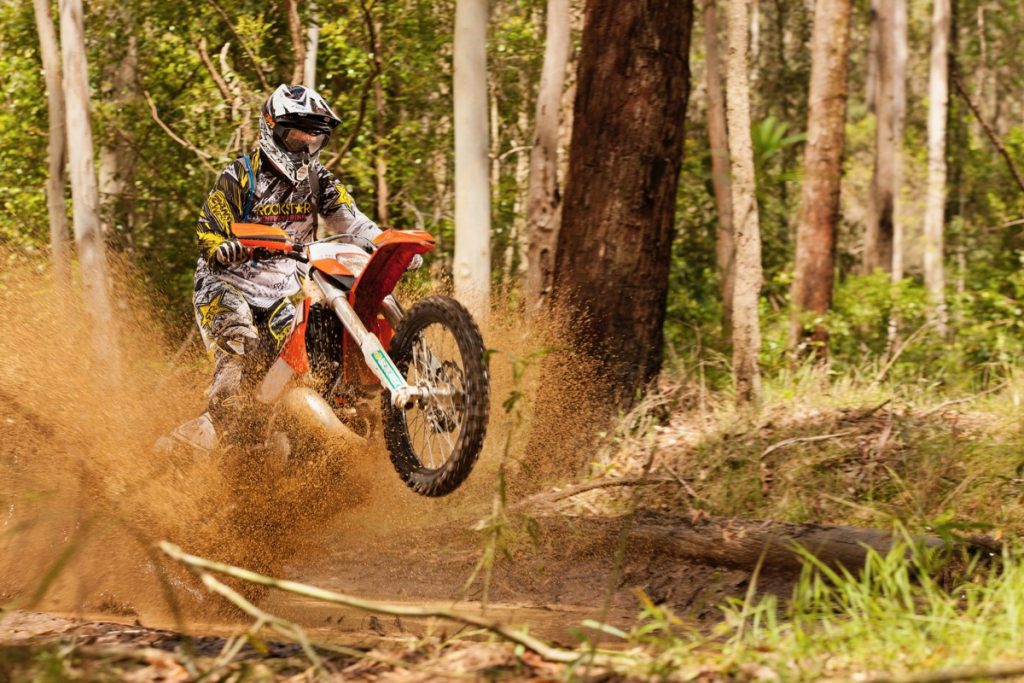
When we awarded KTM’s 300EXC the two-stroke class crown in the 2010 Big Bore Shootout (July 2010 issue), it seemingly could do no wrong. KTM’s R&D department obviously agreed, as this year the most important change is a clear plastic fuel tank! We reckon they were on the money.
Orange Juice
Four-stroke fans considering the switch to an oil-burner would be hard-pressed to go past the easy-to-ride 300EXC. It’s the closest 300 two-stroke to a thumper and the benchmark for a 300 two-stroke in the bush.
There’re no nasty surprises with the donk, just gobs of usable, torquey power and the smoothest, most linear power delivery out there. The standard engine curve can be customised to your liking by unplugging a wire to access a milder ignition map (where’s the handlebar-mounted switch?), while removing a couple of bolts on the right side of the engine allow you to swap power valve springs to tame it further or transform it into a hard-hitting beast.
Brett Kenny preferred the standard map with the aggressive spring, which he felt improved torque off the bottom, while Geoff Braico’s choice was the standard spring and the aggressive map. Regardless of which combination works best for you, the KTM engine gives you options.
It’s so smooth you think it’s got to be slower, but held wide open it was the winner of the drag race! In the bush it’s just as deceptively fast, as the tractable output finds grip and creates momentum, even through the snottiest conditions. It’s responsive to how you want to ride it – whether you want to idle around, or light it up with the clutch.
Complimenting the smooth engine is a slick six-speed gearbox for 2011 and light action Magura hydraulic clutch – all of which makes technical hilly terrain or treacherous waterlogged trails virtually effortless.
Fruit picking
As a whole, the KTM package is extremely hard to fault. Build quality is excellent, while the ergos and handling characteristics are neutral and accommodate the majority of riders with a very short adjustment period.
For 2011, KTM has ditched the black fuel tank for a clear one, leaving only Husky owners staring into the dark abyss to wonder if they have enough juice. The suspension at both ends is plusher than a duck-down doona, but sits up enough in the stroke so balance and geometry aren’t affected.
From fourth-gear power slides to standing two-wheel brake slides into tight singletrail switchbacks, the KTM stays settled and composed, increasing rider confidence with each railed rut or destroyed berm. When backed off to cruising pace Brett Kenny noticed trail junk caused deflection in the front-end, which was eliminated by gassing on and building stabilising momentum.
At 985mm the KTM and Husaberg’s seat height is the tallest of the troupe, with a racier “on top” riding position, compared to the lazier “sit in” feel of the Husky and the Gas Gas. The only complaint from Grabbo was levelled at the standard KTM grips, which are too aggressive for his manicured mitts.
Lastly, the Brembo brakes are impressively strong and predictable, proving their worth within the first few minutes of Day Two, when I met a fast moving pair of riders on a tight section of singletrail. Despite the wet conditions the KTM pulled up instantly with just one finger on the front brake. Full marks.
The last word
The KTM is the Jack of All Trades, equally at home cruising the trails of the world, or laying down competitive special stage times.
The suspension is a little on the soft side, especially at the front, however this makes it a magic carpet ride for the majority of riders.
Lap times
Pro Lap = 1:53.07sec
Expert Lap = 1:59.19sec
Husaberg TE300

After over two decades as “the four-stroke force”, Husaberg has finally ventured into the realm of the oil-burner, with one hell of an impressive debut. Is it just a re-badged KTM or something even better?
Bergalicious
When details of the new Husaberg two-strokes first emerged, it’s fair to say we were a little disappointed. Sure, sharing 98% of its DNA with its KTM cousin meant it would be a good thing, but after the excitement surrounding the 70° engine configuration of the four-stroke range we were hoping for a radically different donk, or – at the very least – something with direct injection.
After spending three solid days on the ’Berg over two separate tests, we’re happy to take it all back. The KTM-crafted engine is brilliant and it’s virtually impossible to fault – not just for any off-road application, but for all levels of rider, from careful beginner to seasoned Pro.
Where the ’Berg motor differs from the KTM is in the fitment of the handlebar-mounted map switch, which KTM buyers have to purchase separately from the KTM Powerparts catalogue.
The only downside to the unit is it’s a huge push-button-style jobbie, rather than a basic up/down one like those found on the TM and Gas Gas. Not only is it impossible to tell which position it’s in at a glance, but you can also accidentally bump it to other maps with your body, when forging through tough terrain.
The KTM electric start mechanism is known for being temperamental and owners of the Kato 300EXC or TE 300 should also be aware the system is vulnerable to water. Our test TE 300 stubbornly refused to fire on the button on Day One, due to corrosion from a drowning incident the week before (with someone else) and had to be replaced.
Spring loaded
“Race-ready”, “progressive”, “perfect” and “heaven” – just some of the words gushed by our five testers about the Husaberg’s awesome closed-cartridge WP fork. Like the legs of a Swedish supermodel, the ’Berg seems equally at home cruising lazily around your back yard as it would parading on the international stage. Compared to the standard-spec WPs adorning the KTM, the ’Berg’s fancy fork is as good as a revalve and well worth the $500 price jump at the showroom. It sits up in the stroke, doesn’t dive in corners, handled the big hits and absorbed the small stuff without deflection, all the while offering the kind of feedback to the rider that makes you feel at one with the terrain. “It’s ready to race and I wouldn’t change a thing on it,” beemed Grabbo. “To be honest, I can’t fault it and will be asking for that setting and trying it in my KTM!”
While the KTM and Husky forks were excellent until pushed hard, and the TM only came into its own on the gas, the ’Berg’s fork effortlessly spanned the whole spectrum of riding styles with the same confidence-inspiring brilliance.
The TE’s suspension, front to rear, was the most predictable and balanced, with the fork working perfectly in tandem with the rear shock. Simply put: the ’Berg is a much more cohesive and complete package than the rest of the class and effectively fills in the few handling and suspension gaps left open by the KTM.
The last Word
Although not delivering the innovation the Husaberg name has become associated with in recent years, the TE 300 has strutted into the ring with its gloves off and the experience of KTM in its corner. Not content to be just as good as the 300EXC, Husaberg have made the TE even better.
Lap times
Pro Lap = 1:52.04sec
Expert Lap = 2:01.24sec
Gas Gas EC300
Thanks to EWC hotshot Christophe Nambotin at the helm of the machine’s development, the 2011 EC300 comes out swinging with a great steering, plushly suspended package and a torquey, user-friendly engine.
Dirty Torque
2009 AORC E3 Champ, Geoff Braico was highly impressed after swinging his leg off the EC300, “No wonder Nambotin smashed us at the Six Days! He’s obviously done a really good job with the 300 two-stroke.”
If KTM discovered the holy grail of off-road engines with their 300 two-stroke, Gas Gas has also come pretty close with the EC300, which virtually mimics the EXC’s power curve but with 2-3hp less across the rev range.
While some racers might miss those ponies, most trail riders will be better off leaving them out to pasture and enjoying the camaraderie of the crisply jetted, six-speed power plant. There’s no hesitation, no lag and – best of all – no energy sapping abruptness to get you out of shape.
This year’s donk has a broader spread of power than Gas Gas’s of years gone by, which is partly due to the FMF Q series silencer and dual curve ignition switch on the handlebar.
The livelier “dry” setting suited everyone to a tee, even in the slippery, root-infested pine sections. However, the “rain” setting, tweaked for maximum traction, made it too docile for our tastes. It’s smoother and easier to ride than the TM or Husky, and sits just a whisker behind the KTM and Husaberg cousins for outright performance.
Another area Gas Gas closed the gap to their competitors is in the addition of an optional electric leg for 2011 – a great move and sure sign they’ve been listening to their customers. Although extensively tested, it’s not perfect yet, as a couple of our testers found it occasionally reluctant to engage, particularly on the second day of the shootout.
Marshmallow man
Complimenting the smooth engine is a suspension package right on the money for trail riding, soaking up forest debris and choppy fire roads with equal ease. It’s a firmer setup from previous Gas Gas’s, but still a smidgen on the soft side for racing.
Geoff “I can see my house from here” Braico found it the easiest bike of the five to bottom, however it still handled a ridiculous 2.5m vertical drop from his stump jump (gracing this issue’s cover).
When pushed hard, the 48mm Sach fork revealed a mild mid-stroke spike on medium-sized bumps, while the rear Sachs shock felt mushy and blew through the stroke on bigger hits. Happily, while heavier springs will be in order for heavier or faster riders, there’s a huge range of adjustment available using the clickers to satisfy most punters.
Where its EWC race heritage starts to show is on flowing terrain at hyper warp speed. Gas Gas has created an impressively stable and predictable ride, which lets you relax even while trees and terrain blur past. The trade off is it’s not the quickest turning bike (although it still steers nicely) and you have to flow through turns, rather than chopping and changing your lines at the last minute.
There’s a real “sit in” feel to the Gas Gas, with the seat to peg relationship feeling the shortest by a long way. While this should make the Gas Gas perfect for shorter riders, the ape-hanger height of the Hebo ’bars seems tailored to taller riders. We’d like to split the difference with another inch of seat foam and a slightly lower ’bar bend. The build quality and attention to detail are obvious.
The Last Word
The EC 300 Electric Start is a fantastic trail weapon which looks great and impressed our Pro riders with how little it would take to make competitive. A worthy contender.
Lap times
Pro Lap = 1:53.67sec
Expert Lap = 2:04.32sec
Verdict
Yes folks, the boys at ’Berg weren’t playing around when they mixed up this potent blue brew. One could even wonder what parent company KTM were thinking letting them release a bike with all the fruit of their best selling 300EXC, but garnished with a better fork, map switch and flavour-of-the-month ’Berg styling. What Husaberg have created is the best 300cc two-stroke enduro bike and a serious challenger to any bike of any off-road class, including its mighty FE 570 big brother. While the Husky and TM cater for the agro end of the spectrum, and the Gas Gas and KTM the trail to intermediate sector, the Husaberg spans the whole gamut of riding, from trail pace to national-level racing, straight out of the crate. The only snag is just 60 of them remain on dealers’ floors as we went to print! If you’re lucky enough to have one parked in your garage, it might be an idea to double your locks or roll out your swag next to it on those dark, lonely nights – you can bet
you arse everyone will want it.
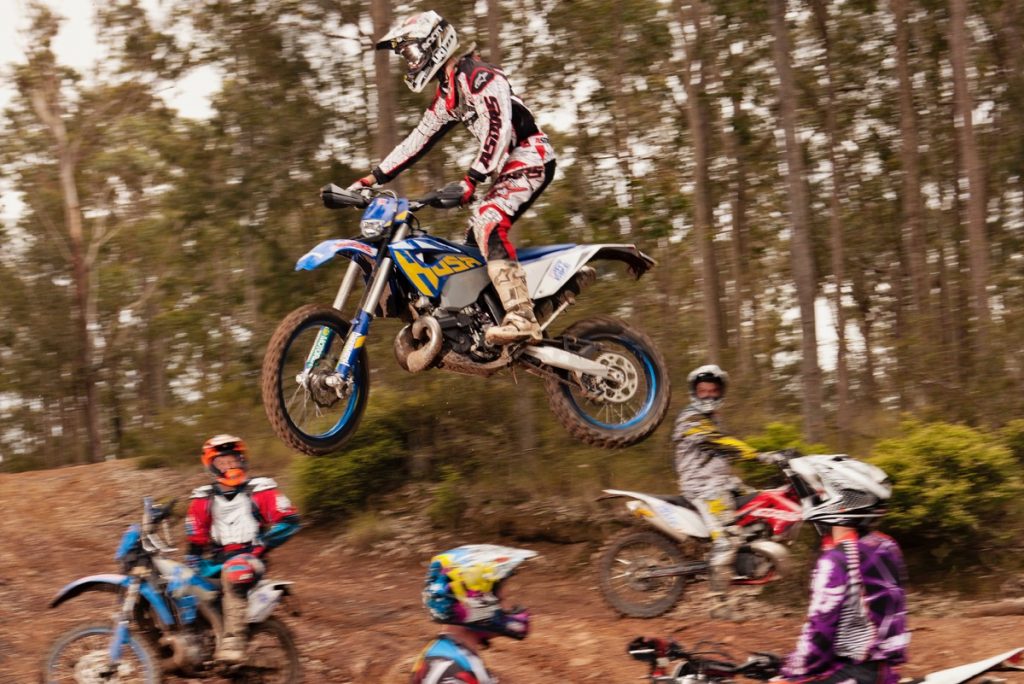
Rider Feedback
Ben Grabham
“I’d race the ’Berg and trail ride the KTM, which probably sounds biased, but I’m being honest! The Gasser has improved a lot and is sitting just in the KTM and ’Berg’s shadow.”
Geoff Braico
“I have to agree with Grabbo – everything works really nice with the ’Berg and KTM. The Kato is nice and plush, with a clear tank this year, which makes it easier to see your fuel level than on the ’Berg. I was really surprised with the Gas Gas, I really liked it and don’t think it would take much to turn it into a great machine on-par with the ’Berg. The Husky feels a bit dated and the TM would take the most work to set up to race for me.”
Brett Kenny
PACE: Expert
“For racing or hard-edged riding, there’s no question: I’d choose the ’Berg. It’s hands down the best package – you can tune the engine and the suspension’s great for trail riding and racing. The Husky also impressed me as a trail bike, because it’s so nice and easy to ride. All that lets it down is the kick starter, and once Husky get a hydraulic clutch and modernise the bike, there’s no reason they won’t be right up there.”
Chris Jones
PACE: Clubman
“If I was to race again I’d take the ’Berg simply for its fork, which makes it the most confidence-inspiring package. For trail riding, it’s hard to go past the KTM, especially with the amount of dealers out there to support it. The Gas Gas was really tractable with a really comfortable, nicely spaced-out cockpit”
Ant Lyon
PACE: Clubman
“This year, the ’Berg was the clear winner for me and a spectacular debut for what was, up to now, a four-stroke-only company. The TM and Husky were a blast, but harder work to hang on to. The Gas Gas was a much improved, hot looking offering although I found it hard to gel with the strange “sit in” ergos and the suspension which was overly soft for my weight.”
